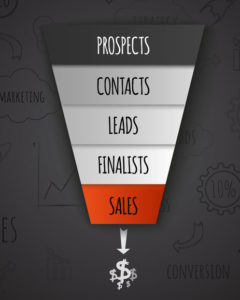
By Bruno Lucarelli
It seems there’s a different version of the purchase funnel for every industry, and rightly so. Business to Business (B2B) is certainly a different process than Business to Customer (B2C), and the size and frequency of the purchase affects the decision making process.
Car dealerships have a funnel that breaks down to three key steps: Needs, Features and Pricing. However, as dealers have moved to digital advertising, much more emphasis has been placed on the bottom of the funnel. It makes sense on the surface: if less than 10% of the general public is actually in the market for a new or used vehicle, why advertise to 100% of them through media such as TV or radio? To give you an idea of how effective this strategy has been, we used the bottom funnel as our main graphic when pitching Autotrader to manufacturers and dealers in 2004. We were selling the bottom funnel customers. Why spend all that advertising money on anything else? It worked, but maybe too well.
Most dealers I speak with now are only interested in the people who are actively seeking a vehicle in the next 10 days – people who are already inquiring about pricing. That’s great, but how do they perceive you and your store? This is a concept not shaped in the bottom of the funnel.
It’s time to start incorporating all three phases of the purchase funnel into a dealership’s marketing plan. It entails taking an all-encompassing look at inventory and shopper demographic. Here are some ideas to get started:
Needs
It all starts with one question from every customer: “What kind of car do I need?” This stems from another fundamental question: “Why do I need this type of car?” For example, shoppers looking for a SUV might be doing so because they’re looking for a vehicle that’s easier to get into and out of, or want a more capable vehicle to take them on their outdoor adventures.
Of course, there are also plenty of empty-nesters downsizing: soccer moms and dads finally getting that convertible that wasn’t practical when chauffeuring the kids to games all over the state.
A growing segment of shoppers are also done with fossil fuels. They want electric vehicles. Dealerships with a demographic that lines up with those demands will need to have a few of those vehicles in their inventory.
 These are all needs that bring people to a specific model and ultimately to a dealership. Give all body types equal time on your website, front page, and social media. When it comes to targeted keyword advertising, try leading with ads that match the “Needs” keywords, such as “small suv” or “station wagon.” Another common search is “least expensive cars to maintain.” If a vehicle fits that category, marketing should target these searches with specific ads noting a lower cost of ownership. Saving money is usually an important “need,” and if shoppers are ready to drop thousands on a new car, they don’t want to dump a ton of money into maintenance. You can use Google Keyword Planner to generate other keyword ideas, massaging those results into the marketing strategy.
These are all needs that bring people to a specific model and ultimately to a dealership. Give all body types equal time on your website, front page, and social media. When it comes to targeted keyword advertising, try leading with ads that match the “Needs” keywords, such as “small suv” or “station wagon.” Another common search is “least expensive cars to maintain.” If a vehicle fits that category, marketing should target these searches with specific ads noting a lower cost of ownership. Saving money is usually an important “need,” and if shoppers are ready to drop thousands on a new car, they don’t want to dump a ton of money into maintenance. You can use Google Keyword Planner to generate other keyword ideas, massaging those results into the marketing strategy.
Features
The American auto industry lost ground to Japanese brands in the 1970s due to customer attraction to cool new features such as cup and sunglasses holders and other small conveniences. Some customers spend hours a day on their cars, so thoughtful touches can make a big difference.
Buyers are also looking to upgrade when they purchase, so a long, hard look at features in newer inventory (2015 or later) might be in order.
Vehicles evolve over time and there doesn’t need to be a new generation for a model to get updated with a ton of new features. Every change matters to someone. More cubic footage? Shout it from the rooftops! Anticipating inclement weather in the upcoming winter? That’s a perfect time to highlight models with all-wheel drive. For millennials, the vehicle’s ability to interface with their current smartphone is a very big selling point. Every new feature in the last five years should be mentioned. Those heated seats just might be the tie breaker that moves the car.
You know your brand, but your customers most likely do not. If you want to get them in for a test drive, put the most recent features up front.
Pricing
Once customers narrow down their search to one or two brands, it’s time to bargain hunt. Did you know that no matter what brand you choose, when you type “(brand) lease,” one of the top suggested search terms will be “deals?” That means that, for every relevant ad and page, the relevant words and phrases should be incorporated into the SEO: linking, meta titles, and keywords will help your site thrive for these search terms.
Some dealerships will search for their brand and be happy when they see themselves as in the top 3 Google results. These phrases will not be used by the bottom funnel buyers, however. Those shoppers with money in hand are looking for deals, and the syntax used isn’t much more complicated than that!
I recommend AdWords programs that automatically post the desired lease price with every specific model search, and and ensuring that the most popular model is listed with the lowest lease price for ANY brand search. Factory-approved SEM agencies should be able to post the latest factory lease price from their data sets.
If customers haven’t settled on their nearest dealer for a purchase, more comprehensive funnel advertising offers a great chance to snag new customers both within and outside your PMA. Paying close attention to every level ensures multiple chances for new customers, at every stage of shopping.












